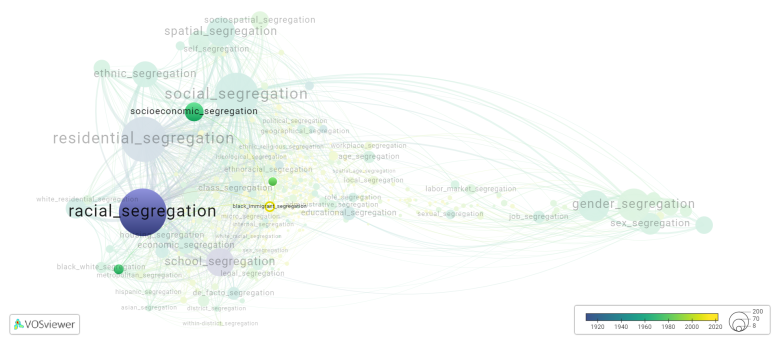Black immigrant segregation: Difference between revisions
(Creating page) |
(Creating page) |
||
| Line 19: | Line 19: | ||
Black immigrant segregation is frequently discussed in the literature with the following segregation forms: | Black immigrant segregation is frequently discussed in the literature with the following segregation forms: | ||
immigrant segregation, black segregation | [[immigrant segregation]],[[black segregation]] | ||
[[File:black_immigrant_segregation.png|780x780px]] | [[File:black_immigrant_segregation.png|780x780px]] | ||
For the complete network of associated segregation forms, see: | |||
clusters https://tinyurl.com/2d8wg5n3 | clusters https://tinyurl.com/2d8wg5n3 | ||
Revision as of 09:18, 26 September 2024
Date and country of first publication[1]
2019
United States
Definition
Black immigrant segregation refers to the practice of isolating or separating Black immigrants in specific neighborhoods, schools, or communities based on their race or immigration status. This segregation can take various forms, such as:
1. Residential segregation: Black immigrants may face residential segregation, where they are concentrated in specific neighborhoods or housing developments separate from the rest of the population. This can be due to discriminatory housing practices, socioeconomic factors, or cultural isolation.
2. Educational segregation: Black immigrant students may experience segregation in schools, where they are disproportionately placed in schools with high concentrations of other Black immigrant or minority students. This can lead to disparities in educational resources, quality, and outcomes.
3. Social segregation: Black immigrants may face social segregation, where they are excluded or isolated from mainstream social, cultural, or economic opportunities. This can result from discrimination, language barriers, cultural differences, or limited social networks.
4. Economic segregation: Black immigrants may be subject to economic segregation, where they are concentrated in low-income jobs, industries, or neighborhoods with limited access to resources and socioeconomic mobility. This can result from discrimination, limited educational opportunities, or systemic barriers to economic advancement.
These forms of segregation can contribute to multiple disadvantages for Black immigrants, including limited access to quality education, healthcare, employment opportunities, and social integration. Addressing these issues requires policies and practices that promote integration, equal opportunity, and dismantling systemic barriers to create more inclusive communities for Black immigrants.
See also
Related segregation forms
Black immigrant segregation is frequently discussed in the literature with the following segregation forms:
immigrant segregation,black segregation

For the complete network of associated segregation forms, see:
clusters https://tinyurl.com/2d8wg5n3
year of publication https://tinyurl.com/2235lkhw
betweenness centrality https://tinyurl.com/223udk5r
disciplines where segregation forms first appeared https://tinyurl.com/244d8unz
References
Notes
- ↑ Date and country of first publication as informed by the Scopus database (December 2023).
At its current state, this definition has been generated by a Large Language Model (LLM) so far without review by an independent researcher or a member of the curating team of segregation experts that keep the Segregation Wiki online. While we strive for accuracy, we cannot guarantee its reliability, completeness and timeliness. Please use this content with caution and verify information as needed. Also, feel free to improve on the definition as you see fit, including the use of references and other informational resources. We value your input in enhancing the quality and accuracy of the definitions of segregation forms collectively offered in the Segregation Wiki ©.
Black immigrant segregation appears in the following literature
Tesfai R. (2019). Double Minority Status and Neighborhoods: Examining the Primacy of Race in Black Immigrants’ Racial and Socioeconomic Segregation. City and Community, 18(2), 509-528. Blackwell Publishing Ltd.https://doi.org/10.1111/cico.12384
